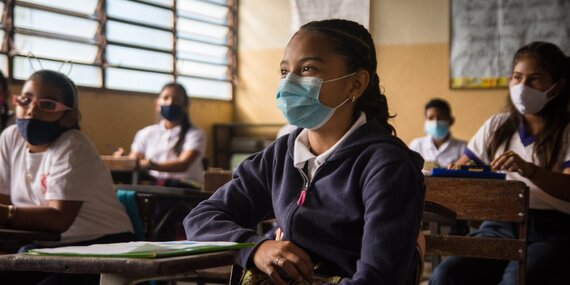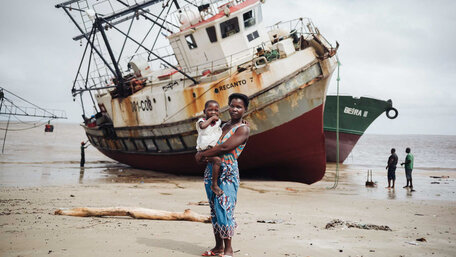Caracas, Venezuela
Children during classes at Las Mayas Fe y Alegría institution in Caracas, Venezuela, October 2021. This was the first week of in-person classes in Venezuela since the pandemic began. UNICEF/Gustavo Vera
Latin America and the Caribbean is the world’s most economically unequal region and the second-most disaster-prone region. Recovery from the pandemic has been challenging. Despite comprising only 8.4 per cent of the global population, Latin America and the Caribbean has been the world’s hardest-hit region, with 18.5 per cent of all global COVID-19 cases and 30.3 per cent of all deaths.
The pandemic’s effects have had a significant impact on the region’s poverty, displacement, food insecurity and violence. As the response in 2021 pivoted to longer-term operations, it is highly likely that the humanitarian community will be operating in a post-pandemic Latin America and the Caribbean for years to come. Challenges to economic growth, unequal access to or acceptance of COVID-19 vaccines and the threat of severe climate-related risks remain ever present.
The region is still experiencing the impacts of the higher number of sudden-onset disasters and the record-setting Atlantic hurricane season in 2020. Targeted multisectoral response has been mounted to help address the growth in needs caused by the various impacts of 2020. El Salvador, Guatemala and Honduras alone saw their populations in need grow by 60 per cent in 2021. This unprecedented increase prompted the launch of Humanitarian Response Plans in these countries, totalling $588 million in requirements for 2021-2022. However, the plans have collectively received only 11 per cent funding so far.
Latin American and the Caribbean: Appeal Overview
The ongoing presence of La Niña is contributing to disruptions in global climate patterns and to South America’s second warmest year on record. The Gran Chaco lowlands area, which is roughly twice the size of California and spans parts of Argentina, Bolivia and Paraguay, saw one of its worst droughts in 60 years. This has aggravated seasonal wildfires and disappearing water supply sources, and it is affecting agricultural production and drying up waterways vital to services, commerce and food security. An estimated 2 million people exposed to severe drought in this area may require humanitarian assistance, leading to a scale-up of monitoring and operational readiness.
Latin America and the Caribbean
These recurring and increasingly drastic climate shocks come against a backdrop of challenging conditions. According to the UN Economic Commission for Latin America and the Caribbean, the region’s 5.9 per cent growth in GDP and 6.7 per cent growth in employment in 2021 will not be enough to offset the world-leading declines. Many countries in the region are managing to get their economies slowly back on track thanks to COVID-19 vaccination roll-outs - reaching more than 50 per cent of their populations. Despite this, less than half of the region’s population is fully vaccinated, with countries facing obstacles to securing vaccine supplies, logistics challenges and, in some cases, vaccine hesitancy.
Unequal vaccine access is also hampering vaccination efforts. This particularly affects marginalized groups such as rural communities and indigenous people, who already experience long-standing disadvantages in receiving adequate health coverage. The few countries that do provide specific vaccination data on indigenous people cite low numbers. Guatemala reports 134,000 fully vaccinated indigenous people, just 2 per cent of the country’s indigenous population. In Brazil, about one in every three indigenous people was vaccinated as of August 2021.
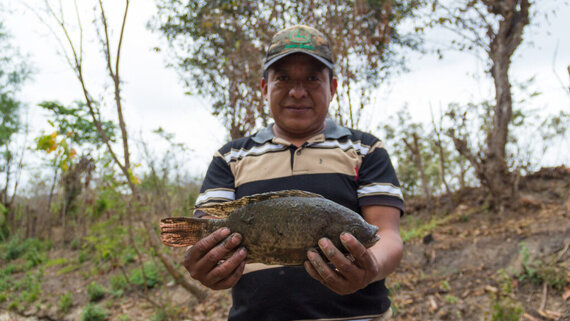
Chuxolop, Guatemala
A man holds up one of hundreds of fish that have died in Chuxolop lagoon, in Guatamela. Severe drought is causing the lagoon to dry up, and the receding water doesn’t have enough oxygen to keep the fish alive.
WFP/Miguel VargasThere has been a 9 per cent increase in moderate-to-severe food insecurity, which now affects 267 million people across the region — the world’s sharpest increase from 2019 to 2020. State response capacities are becoming increasingly strained due to weakened institutions and significant tax revenue losses, while chronic violence is returning to pre-pandemic levels in certain countries.
Gender-based violence risks are increasing for women, initially caused by prolonged confinements with their aggressors during the 2020 COVID-19 lockdowns. Women continue to be subjected to unequal labour opportunities during the recovery in 2021, which would otherwise grant them greater autonomy. Latin America and the Caribbean is one of the world’s most dangerous regions for women. The regional rate of 4.6 female homicides per every 100,000 women is double that of the world rate of 2.3. Risks for women are even higher in Central America, which records 5.8 as the subregional rate.
Children are also experiencing hardship. The region has had the world’s longest uninterrupted school closures due to COVID-19-mitigation measures. These closures have left 86 million children out of classrooms and caused the loss of 153 in-person schooldays. Only 22 per cent of the region’s countries have fully opened their schools. This is the lowest number for any region in the world not currently on an academic break.
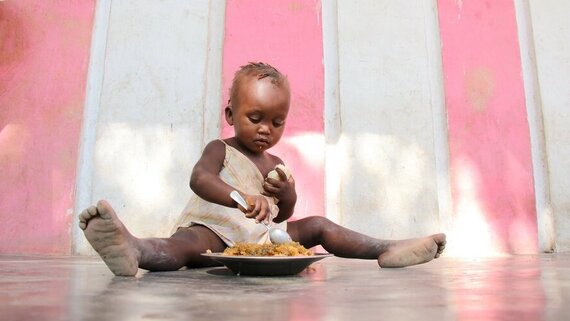
Gonaive, Haiti
This baby's mother says few buyers brave the insecurity and roadblocks to reach the Plateau market in Gonaives, a primary marketplace for much of northern Haiti, where she sells her produce. "We do not live well, we do not eat well, and we cannot even move around normally because of the chaos in the country," she said. She grows fruit and vegetables on her small plot of land outside Gonaives, the largest city in Haiti's Artibonite Department. "We used to sell what we harvested in our fields, but now we can't."
WFP/Alexis MasciarelliIn 2021, internal displacement flows grew to historic levels. The Internal Displacement Monitoring Centre placed Brazil, Cuba, Guatemala and Honduras among the 25 countries in the world with the highest number of new displacements due to disaster or conflict in 2020. In Honduras, 937,000 people were displaced due to disasters, almost a tenth of its population.
According to the United States border authorities, the Mexico-US border saw the arrival of a record 1.7 million migrants from October 2020 to September 2021. This is 20 per cent more than the number of arrivals in 2020 and 2019 combined. Children and adolescents accounted for more than 149,000 of these migrants. Throughout 2021, the number of underage migrants has grown each month. An increasing number of migrants in countries across the region originate from Haiti, triggering calls for a region-wide and coordinated humanitarian response. Given its position as a country of transit, joining South America and Central America, Panama expects 150,000 migrants, mostly from Haiti, to cross the treacherous Darien jungle in 2021. This is almost equivalent to the number of migrants who previously entered Panama between 2009 and 2020.
This situation, together with the ongoing plight of millions of Venezuelan refugees and migrants in host countries across the region, may escalate further. An increasingly contentious socio-political landscape in Nicaragua and deteriorating conditions have already caused thousands of people to flee to neighbouring countries since April 2018.
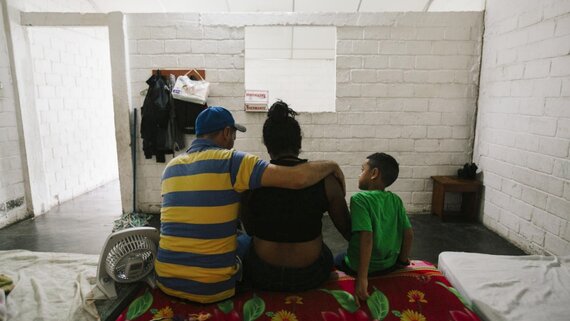
Tapachula, Mexico
A family from Central America waits at a shelter in Tapachula, southern Mexico.
UNHCR/Gabo MoralesThe majority of the region has not seen widespread conflict in decades and has a comparatively higher degree of political stability. However, countries including Antigua and Barbuda, Argentina, Barbados, Bolivia, Brazil, Cuba, Ecuador, El Salvador, Guatemala, Panama, Peru, and St. Vincent and the Grenadines saw protests or violence in 2021. These were related either to gaps in pandemic response, slow vaccination rates, insufficient measures to offset the pandemic’s socioeconomic impacts, or opposition to political or economic reform.
2022 will be critical in responding to the region’s growing needs, as its various crises continue to play out during an arduous recovery from a global pandemic. Economic rebounds are expected to slow down in 2022 in the context of deepening structural issues across the region and downward pre-pandemic economic and employment rates. Across the region, more than 287 million people (46 per cent of the population) are now in poverty or extreme poverty. Financing in the region must scale up to tackle continued structural problems and limits to Government assistance, as well as growing climate risks, food insecurity and displacement. Action is needed from middle-income countries to scale up, as their Governments face mounting needs among people living in vulnerable conditions facing recurrent shocks and natural hazards.
Further reading
Source: OCHA
Source: OCHA
Colombia
Analysis of the context, crisis and needs
Over the past decade, Colombia has witnessed significant development advances. The 2016 Final Agreement to End the Conflict, signed by the Colombian Government and the former FARC guerilla, brought a period of relief not seen in decades. Despite this progress, surging socioeconomic needs in peripheral and urban areas due to COVID-19; the expansion and strengthening of organized non-State armed groups (NSAGs) in parts of the country; an increased impact of natural disasters; social unrest; and the integration of 1.8 million Venezuelan refugees and migrants have been the key drivers of an increase in humanitarian needs in Colombia.
In 2021, organized NSAGs have expanded rapidly in peripheral areas of the country, creating an increase in hostilities and violence affecting civilian populations, particularly ethnic minorities. Increased use of explosive ordnance, including improvised landmines, has been reported, particularly in rural areas and regions bordering neighbouring countries, where illicit crops and other illegal economies are located. In 2021, indigenous communities have been gravely affected by explosive ordnance, recording a 20 per cent increase in indigenous casualties compared with 2020. The increase in recruitment of minors has also been reported. 2021 witnessed the highest number of people affected by mass displacements and confinement in the last decade and a continuous trend in confinement affecting more than 113,000 people this year.
The frequency and severity of meteorological events due to climate change are also driving humanitarian needs and exacerbating the vulnerability of communities (Colombians and refugees and migrants from Venezuela). Extreme weather events, such as Hurricanes Eta and Iota in 2020, and the development of La Niña in the last quarter of 2021, have had significant consequences on the lives and livelihoods of affected communities, particularly due to the impact of severe floods and torrential rains, mainly in coastal areas. Access to health care, including emergency health care, is also a major concern and poses increased risks to lives. So far in 2021, disasters have affected approximately 600,000 people.
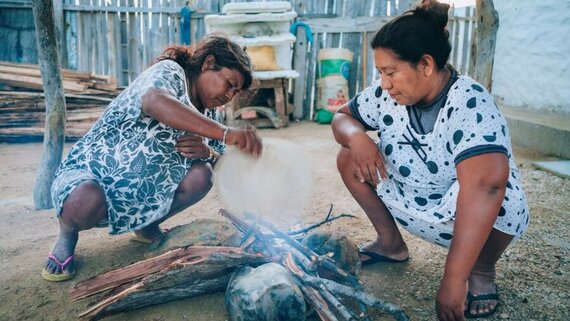
La Guajira, Colombia
Two women, cook over a wood fire. For decades, life in the desert peninsula of La Guajira in northern Colombia, home to the Wayúu indigenous community, was marred by conflict and paramilitary violence. Driven by fear, people would cross the border into Venezuela, where many sought — and found — safety and a better life. However, when things deteriorated in her adopted homeland, she was among the hundreds of thousands of Colombians who decided to return. One of the women said: "We had to leave behind all the fruits of our work and come back empty-handed. But after 20 years, the community welcomed us back with hugs and tears." Marginalized, indigenous people are often disproportionately affected by poverty. According to the World Bank, they account for just 5 per cent of the world's population but comprise 15 per cent of the extremely poor. and a third of the world's rural poor.
WFP/Michael BloemRecord numbers of transcontinental population movements in the Americas were witnessed in 2021. These flows that comprise a large number of persons from different countries (mainly Haitian, Cuban and Venezuelan nationals, as well as other nationalities crossing Colombian territory end route to Central and North American countries have generated significant protection risks, especially as they traverse across the dangerous Darién Gap on foot. However, despite the official closure of the Colombia-Venezuela border for most of the pandemic, population flows of Venezuelan refugees and migrants into Colombia continued, mostly through irregular border crossings. Significant advances were made in granting Temporary Protection Status to Venezuelans, which will facilitate their access to basic services and job opportunities for socioeconomic integration.
The COVID-19 pandemic has increased the demands on the Government and affected the most vulnerable people in Colombia, leaving significant socioeconomic impact and compounding the existing humanitarian challenges. Due to the pandemic and the reconfiguration of emergencies, there is significant strain on health personnel, surveillance systems, information, and response efforts. There is an urgent need to continue supporting health personnel, communities, institutions and health authorities, particularly in geographically dispersed areas facing difficulties accessing health services. Rising levels of food insecurity and malnutrition and decreased livelihood opportunities, among other affectations, have specially affected to 3.8 million women and 2.4 million children, and increased school dropout rates due to a lack of access to virtual education have exposed children to high risks of recruitment by NSAGs and increased cases of teenage pregnancies. The Pacific region, which includes Cauca, Valle del Cauca, Chocó and Nariño Departments, is particularly impacted by these dynamics.
These humanitarian challenges have increased the number of people in need - from 6.7 million people in 2020 to 7.7 million people in 2021. These numbers exclude Venezuelan refugees and migrants in Colombia, which are analysed in the Refugee and Migrant Response Plan 2022.
Projected situation in 2022 and beyond
Humanitarian needs are expected to continue throughout 2022, underpinned by four drivers: internal armed violence, disasters, migratory movements (transcontinental mixed population movements, continued movements of Venezuelan refugees and migrants, and Colombian and binational returnees), and the economic and socioeconomic effects of the COVID-19 pandemic. No major changes to Government policies are expected in the coming year due to forthcoming elections.
In this challenging year ahead, vulnerable communities will remain a priority for humanitarian partners. These communities include in particular those in rural and isolated settings and in hard-to-reach areas under the influence and control of NSAGs; communities near entry points for Venezuelan refugees and migrants; and areas where humanitarian access constraints persist for both State entities and humanitarian actors. This is due to the limited coping capacity of these vulnerable communities as well as the existing intersectoral needs of Afro-Colombian and indigenous communities, particularly women, boys and girls. The proposed response will be coordinated and underpinned by intersectoral complementarity.
Colombia HRP
Violence and disasters exacerbated by the impact of climate change are likely to intensify in 2022. The impact of humanitarian emergencies will mostly affect the lives of communities living in high-risk areas, underpinned by in-depth analysis outlined in the HNO 2022. This will significantly impact protection, food security, livelihoods opportunities and coping mechanisms of affected communities, including indigenous peoples and Afro-Colombian communities. In turn, the rapid increase of transcontinental refugees and migrants transiting through Colombia will generate serious protection concerns for these vulnerable communities. As a result, the estimated PiN of humanitarian assistance in 2022 is 7.7 million people, including internally displaced persons, confined people, disaster-affected people, populations under NSAG control, as well as women, children, ethnic groups, persons with disabilities, transcontinental migrants and host communities.
Considering that these drivers are related to historical and structural situations caused by the actions of NSAGs, climate change and migratory flows to North American countries, it is estimated that humanitarian needs will continue beyond 2022.
Response priorities in 2022
In 2022, the humanitarian response in Colombia will continue to focus on communities living in rural areas, as well as in hard-to-reach areas where hostilities persist, and areas with limited coping capacities, high impacts from disasters, recurrent transcontinental migratory flows, and dynamics of multiple causes for intersectoral impact. Humanitarian actors will develop a strategy that is dedicated to the Pacific Coast, where major humanitarian impacts are expected to continue, and with greater emphasis on supporting Colombia's Afro-Colombian and indigenous peoples, as they are disproportionately affected by violence. Humanitarian actors will aim to provide a more integrated multisectoral response, which protects and saves lives through humanitarian assistance and protection, and contributes to lasting solutions, with particular consideration to protection, age and gender needs. Humanitarian actors will further engage in prevention and disaster preparedness measures. Enhancing rapid response mechanisms in the most affected territories will also be a priority. Humanitarian actors will continue to work closely with peace and development actors to maximize resources and attempt to facilitate lasting solutions for those most in need.

Unión Bakiasa, Rio Opogadó, Chocó, Colombia
This photograph was taken during a humanitarian mission by Consorcio MIRE and Alianza por la Solidaridad (APS). During the mission, APS built and rehabilitated several community water houses, distributed several water purification filters to the community, and conducted personal hygiene workshops. The population is under constant threat from illegal armed groups. Armed confrontations, violence and antipersonnel mines force people to move or to live in confinement, without access to basic services and with a high risk of protection and human rights violations.
MIRE/APS/Gisselle SartoriAchievements and innovations
Mobility restrictions of humanitarian personnel throughout 2020 and part of 2021 due to the COVID-19 pandemic had a profound impact on remote civilian populations. This was due to deteriorating insecurity caused by the territorial expansion of armed groups and the socioeconomic impact of COVID-19. The overall message of communities in peripheral rural areas of Colombia was that they felt abandoned. Many reported that the presence of humanitarian partners in their areas served as mitigating factor for abuses and the impact of the control exerted by armed groups.
As a result, the Humanitarian Country Team developed a protection-by-presence strategy aimed at ensuring a greater monitoring and presence by the international community - with the accompaniment of national entities, such as the Ombudsman Office. Combined with increased inter-agency missions to critical areas, as well as the implementation of the Multi-Sector Needs Assessment, this has helped to obtain key information on the daily struggles of many of these communities and to inform response strategies to attempt to mitigate their effects.
Further reading
Source: Humanitarian Insight
Source: Financial Tracking Service
Source: Office for the Coordination of Humanitarian Affairs
El Salvador
Analysis of the context, crisis and needs
El Salvador is among Latin America’s most densely populated countries and faces a diverse array of challenges due to high socio-economic exclusion rates, inadequate urban and infrastructure planning, qualitative and quantitative housing deficits and significant overcrowding. Poverty and food insecurity rates are increasing as purchasing power and livelihoods decrease mainly due to the impact of COVID, further aggravating vulnerabilities and humanitarian need. Approximately 656,000 people live in extreme poverty, representing nearly 10 per cent of the country’s population.
This country is also prone to recurring climate shocks such as droughts, tropical storms and seismic activity, as manifested by the compounded impact of the drought 2018-19, Tropical Storms Amanda and Cristobal, and the Nejapa landslide in 2020. The country suffers from high environmental degradation, making it prone to erosion and landslides.
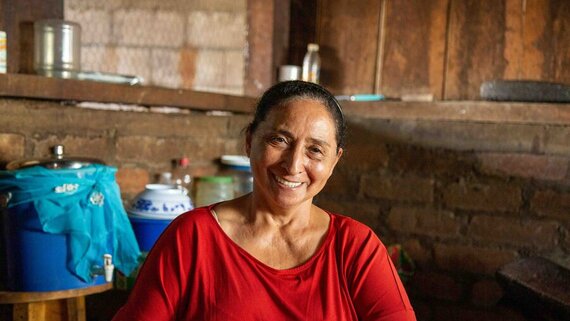
Cacaopera, El Salvador
Years of recurring droughts and an erratic climate have taken their toll on the Torola River, which courses through the Morazán department, in eastern El Salvador. This woman works as a subsistence farmer and is treasurer of Women with Hope, a cooperative born of the efforts of a group of women who clubbed together to weave and sell hammocks after climate change destroyed their crops. She said: “It is a beautiful river — it used to be very large, it had fish, but now the water’s gone down so much.” Food insecurity in this area is around 2 per cent higher than the national 7 per cent average.
WFP/Nick RoederAmid the COVID-19 pandemic, the loss of employment and the increase in food costs due to supply chain disruptions directly affected the nutritional status and overall health of people, especially vulnerable groups such as children under 5 years of age, pregnant women and the elderly. A combination of negative coping mechanisms along with food shortages led to an increase in the number of food-insecure people. The COVID-19 crisis continues to deepen pre-existing vulnerabilities, including gaps in equitable access to address basic needs such as safe drinking water, and inadequate nutrition and health services, including sexual and reproductive health, protection services and other response services for survivors of gender-based violence (GBV). Existing inequities in education have also deepened, including high dropout rates and lack of education resources, such as access to the Internet and quality education infrastructure.
Crime and other types of violence and insecurity (femicides, infanticides, GBV and violence against children) continue to threaten social development and economic growth. Homicide rates have dropped significantly since 2019, but in 2020 there were 19.8 homicides per 100,000 inhabitants, and a national survey reveals that 63 out of every 100 women interviewed had experienced sexual violence. The prevailing level of insecurity continues to drive high levels of forced internal and cross-border displacements. Salvadorans continue to leave the country seeking international protection, and approximately 38,200 were apprehended at the US border between January and September 2021.
Projected situation in 2022 and beyond
The 2021/2022 Humanitarian Needs Overview identified 1.7 million people in need of humanitarian assistance (25 per cent of the Salvadoran population). This is a staggering 164 per cent increase from the 643,000 people in need identified in 2020, before the COVID-19 pandemic and the impacts of Tropical Storms Amanda and Cristobal multiplied existing vulnerabilities. If left unaddressed, these needs will continue to grow in 2022 and beyond, with severe consequences for the most vulnerable groups.
According to projections from September 2021 to February 2022, close to 600,000 (10 per cent of the population) will experience high levels of acute food insecurity (IPC Phase 3 or above). The situation is expected to deteriorate from March 2022 onwards, when 900,000 (14 per cent of the population) will experience a high level of acute food insecurity entering the lean season for the coming months. This season is characterized by high food prices, low labour opportunities, and the likely continued impact of the COVID-19 pandemic. The presence of La Niña through early spring 2022 threatens to bring heavy rainfall, floods and landslides in parts of the country that would affect the agricultural sector.
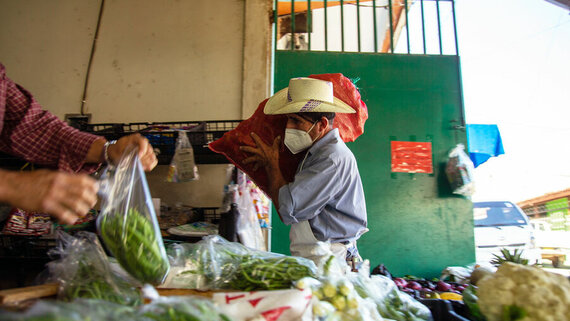
Cacaopera, El Salvador
A Salvadoran farmer delivers vegetables to a local market. Cacaopera is situated in the Dry Corridor, a vast stretch of Central America where El Niño-related drought is pushing more people into food insecurity. Farmers in El Salvador are unable to grow crops, which makes food access difficult for millions of people. In a WFP-supported project, three Salvadoran farmers have turned one of their community’s driest strips of land into a green haven, using a type of cultivation that does not require soil and facilitates intensive farming with minimal water.
WFP/Nick RoederIf poverty, low access to food among households and other conditions of deprivation continue or increase, malnutrition in children and pregnant women will rise, leading to long-term consequences, significantly increasing public expenditure on health and negatively affecting national economic performance.
The number of internally displaced people and people at risk of displacement is projected to increase due to growing insecurity and violence, coupled with aggravated socioeconomic conditions. In 2020, 33,200 Salvadorans applied for asylum mainly in Mexico and United States, bringing the overall number of asylum seekers from El Salvador with pending applications to 149,265.
Response priorities in 2022
In 2022, the humanitarian community seeks to assist 912,200 of the most vulnerable people (around 54 per cent of people in need), many of whom have needs related to livelihoods, protection, health, nutrition, education, and basic water and sanitation. The 2021/2022 Humanitarian Response Plan (HRP), requiring US$156 million, aims to protect and save lives through the provision of protection services and access to rights for people with specific needs according to age, gender, diversity and location. Resources were mobilized quickly for food security and protection within the 2021 portion of the 2021/2022 HRP. However, funding for the other eight sectors would ensure a comprehensive response to multidimensional needs.
El Salvador HRP
The strategic objectives and multisectoral response approach aim to provide coordinated and targeted assistance to address critical needs in high-priority areas prone to the impact of disasters and violence. Additionally, the HRP’s actions seek to support and strengthen sustainable solutions through humanitarian-development collaboration to restore essential services and systems, and to strengthen community and institutional resilience.
Further reading
Source: Humanitarian Insight
Source: Financial Tracking Service
Source: Office for the Coordination of Humanitarian Affairs
Guatemala
Analysis of the context, crisis and needs
Multiple overlapping crises continue to extract a devastating toll on the most vulnerable people in Guatemala. Approximately 8.5 million people – half of the country’s population – live in poverty, dramatically weakening people’s resilience and ability to mitigate their exposure to risk and withstand recurrent shocks.
In 2020, COVID-19 and back-to-back Hurricanes Eta and Iota exacerbated pre-existing humanitarian conditions. The twin storms left 1.8 million people in need of humanitarian assistance. Recurrent climatic shocks, displacement and migration, and food and nutrition insecurity continue to be the main drivers of crisis, as the scale and severity of needs grow among vulnerable people exposed to multiple emergencies. In 2021, the number of Guatemalans estimated to be acutely food insecure (IPC Phase 3 or above) peaked at 3.45 million people. Chronic undernutrition affects 47 per cent of children under 5 years of age, the highest rate in Latin America and the Caribbean. That figure reaches 58 per cent among indigenous children.

Alta Verapaz, Guatemala
A young woman walks barefoot across rubble caused by Hurricane Eta. Guatemala's vulnerability to natural and climatic hazards, together with high poverty and gaps in access to basic services, poses risks exacerbated by COVID-19 and Hurricanes Eta and Iota.
CNS/Luis EchevarriaIn recent years, the deepening of pre-existing vulnerabilities has triggered a staggering increase in mixed population movements and return migration. Between January 2020 and July 2021, more than 235,400 Guatemalan nationals were apprehended at the US-Mexico border. In 2020, more than 8,500 unaccompanied children and adolescents were apprehended by US authorities. Nearly 46,000 people were returned to Guatemala from the US and Mexico in 2020, including more than 4,500 unaccompanied children and adolescents. Returnees confront significant protection risks due to forced recruitment by criminal organizations and different forms of violence, including gender-based violence (GBV).
Almost 2.4 million people have urgent protection needs in Guatemala. Women, children and adolescents, people with disabilities, LGBTIQ+ people, migrants, displaced people, refugees and returnees, and indigenous and Afro-descendant groups have the greatest protection needs. In targeted departments, rates of violent crime, mainly homicides, as high as 934 victims per 100,000 inhabitants were reported in 2021.
Projected situation in 2022 and beyond
The 2021/2022 Humanitarian Needs Overview identified 3.8 million people in need of humanitarian assistance, a 15 per cent increase compared to the 3.3 million people in need in 2020. In 2022, the humanitarian situation is expected to worsen due to a lack of livelihood opportunities, crop failures and interruptions in access to food, and limited coverage of social protection programmes.
The absence of mass vaccination, especially in rural areas and mid-sized cities, places people’s health and livelihoods at risk and threatens to overwhelm an already strained health system. Currently, around 25 per cent of the population is fully vaccinated against COVID-19.
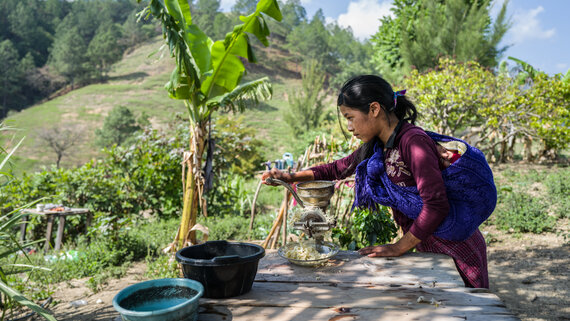
Calico, Guatemala
A young mother prepares a meal in Calico, near the Mexican border. Huehuetenango Department has the second-highest level of people in need, and is one of the 16 departments out of 22 in IPC Phase 3 levels of food insecurity. Huehuetenango was also one of the departments most affected by Hurricanes Eta and Iota.
ACF/Lys ArangoAcute food insecurity was projected to decline between September 2021 and January 2022. However, the number of people classified as “stressed” (IPC Phase 2) is expected to grow by 12.5 per cent compared to May-August 2021, increasing from 7.7 million people to 7.9 million. Cyclical episodes of severe drought and intense hydrometeorological events, facilitated by the presence of La Niña through early spring 2022, will likely continue to affect agriculture, food output and livelihoods, reversing potentially short-lived improvements in acute food insecurity.
Displacement is projected to rise from around 429,000 people in 2020 to more than 578,400 in 2023 (an increase of nearly 35 per cent) due to escalating violence and a deteriorating socioeconomic and human rights situation. Increased migration flows will expose growing numbers of people on the move to significant protection risks, including GBV, trafficking, exploitation and sexual abuse, and reintegration challenges for returnees.
Response priorities in 2022
In 2022, the Humanitarian Country Team (HCT) will respond to the most pressing humanitarian needs of 1.68 million people. This represents around 44 per cent of the 3.8 million people in need.
The 2021-2022 Humanitarian Response Plan (HRP), requiring US$210 million, strategically prioritizes vulnerable groups and geographic areas hardest hit by Eta and Iota, Dry Corridor communities subject to recurrent climatic shocks, and areas with a significant presence of people on the move. Despite initial funding being provided in 2021, several key sectors and cross-cutting issues remain significantly underfunded, including housing, nutrition, GBV, health and livelihoods, leaving critical response gaps that must be addressed.
Guatemala HRP
The HRP’s strategic objectives aim to protect and save the lives of affected people, while also strengthening resilience and the linkages between humanitarian and development actions. The HRP delivers integrated assistance through interventions at the household level to address urgent multisectoral needs, and in the most affected communities to help recover and rehabilitate critical systems and services.
Based on needs assessments and analysis, the HRP prioritizes response actions in five departments, targeting the most vulnerable groups, such as children and adolescents, pregnant and lactating women, subsistence farmers and informal workers, indigenous and Afro-descendant communities, people on the move and people with disabilities. Amid high levels of violence and insecurity, including femicide, GBV and violence against children, protection is a key cross-cutting issue prioritized across the response.

Los Amates, Guatemala
A group of people carry food rations provided by WFP, with emergency funding from CERF. Los Amates is a municipality in the Izabal Department, on the eastern border with Honduras, and one of the departments most affected by Hurricanes Eta and Iota.
WFPThrough the HRP, the HCT is improving access to critical services, including education, health and WASH, re-establishing the food security of families in need through cash transfers and in-kind food assistance, and implementing recovery actions for livelihoods and basic services with a Build Back Better approach.
Further reading
Source: Humantiarian Insight
Source: Financial Tracking Service
Source: Office for the Coordination of Humanitarian Affairs
Haiti
Analysis of the context, crisis and needs
Regularly exposed to natural hazards and the effects of climate change, Haiti faces recurrent socioeconomic and political challenges that are anchored in deep-rooted structural problems. In 2021, the country experienced a profound and disturbing deterioration of the socioeconomic, political and security context. Compounded by the COVID-19 pandemic, and a 7.2-magnitude earthquake that affected more than 800,000 people on 14 August, humanitarian needs have exacerbated, especially in the country's southern region.
The activities of armed groups in the Port-au-Prince metropolitan area, which resulted in the displacement of more than 18,000 people, gained momentum with the assassination of President Jovenel Moïse on 7 July. This compromised humanitarian access particularly on the road to southern departments affected by the earthquake, roads which are under the control of armed groups and often the site of territorial fighting. In October, transport unions and the public protested and struck due to the growing insecurity. Armed groups (with political demands, among others) blocked access to roads leading to Port-au-Prince's oil terminals and significantly hampered fuel distributions. This severely impacted the functioning of health-care services, telecommunications, public transportation, bank services, and humanitarian and emergency relief operations. If this situation continues or is repeated, it could have serious consequences for the country, particularly regarding the humanitarian operations.
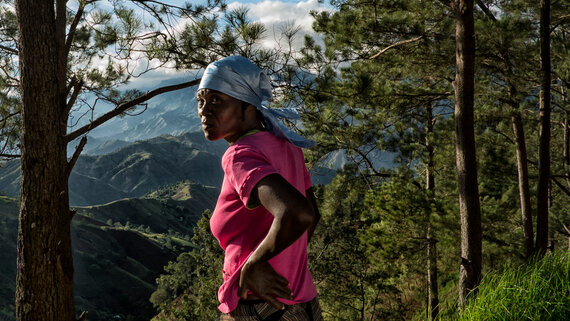
Port-au-Prince, Haiti
A woman stands in front of the mountains outside Port-au-Prince, Haiti.
UN/Logan AbassiThe worrying increase in kidnappings is adding to the sense of insecurity among the population and poses a growing threat to the protection of civilians and humanitarian workers. Insecurity and violence led to internal displacements and lack of safe and appropriate shelters, and increased the risk of gender-based violence (GBV) in a context where essential services are very limited and already stretched.
In addition, inflation, poor harvests due to below-normal rainfalls, Tropical Storms Elsa (July) and Grace (August), and the recent earthquake have all contributed to increased vulnerabilities throughout the country. In September 2021, around 4.3 million Haitians were acutely food insecure, 1.3 million of whom were in a situation of emergency (IPC4), with reports projecting this number to rise to 4.6 million in March 2022.
With more than 900 schools damaged or destroyed by the earthquake (and some used as emergency shelters), between 40 and 70 per cent of schools in the southern part of the country were unable to reopen for the new school year, while 300,000 children were expected to return to school. This is causing a delay in the school programme, a risk of dropout and withdrawal from school, and an increased risk of violence against children, including sexual exploitation and unwanted pregnancies.
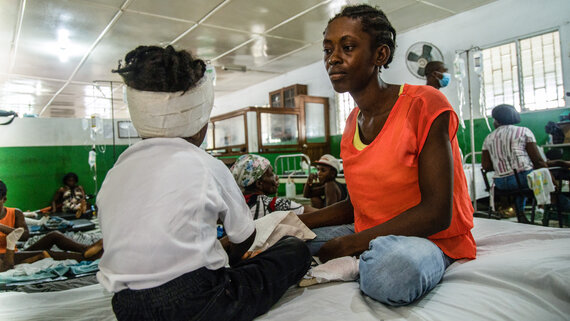
Les Cayes, Haiti
Patients, families and medical staff in two hospitals in Les Cayes receive food and cash assistance. This mother was one of hundreds of people at the hospital, mostly mothers and children, crammed into a large room lined with mats after the paediatric ward was damaged in the August earthquake. Her four-year-old son’s head was wrapped in a bandage due to a deep wound, his eyes nearly swollen shut. She explained: “Our house was completely destroyed with my three children inside; one of my children is now in critical condition. We lost everything. He needs help, he needs medicine."
WFP/Marianela GonzalezThe low levels of access to safe drinking water have caused the transmission of diarrhoeal diseases while aggravating acute malnutrition. The low rate of vaccination against measles, hepatitis and polio (less than 80 per cent in 2021) exposes Haitians, particularly children under 5 years of age, to various diseases and contaminations. Access to health-care structures is a major concern. Damage to health facilities in the earthquake-affected areas further limits the population's access to health services, particularly emergency obstetric and neonatal care, in an already critical context for maternal health (Haiti's maternal mortality rate is 529 deaths per 100,000 live births, the highest in the region).
At the end of October 2021, Haiti had 23,406 confirmed COVID-19 cases and 658 deaths (as officially reported). Even though the number of infected persons remains relatively low compared to other countries, the pandemic poses a major risk to already weakened health structures. Despite a vaccination programme officially launched in mid-July, Haiti has the lowest vaccination rate against COVID-19 in the Americas (0.6 per cent).
In addition to this alarming situation, Haiti is facing a serious migration crisis. Between 19 September and 19 October 2021, IOM Haiti, in support of the National Office for Migrations, received and provided post-return assistance to more than 10,800 Haitian migrants (6,586 men, 2,456 women, 920 boys and 869 girls) repatriated from the United States, Mexico, Cuba, the Bahamas, and the Turks and Caicos Islands. This number adds to the 18,358 Haitian migrants who have been repatriated or expelled between the beginning of the year and mid-September mainly from the Dominican Republic, United States and Mexico, among other countries.
Projected situation in 2022 and beyond
In 2022, the humanitarian situation in Haiti will be influenced by developments in the country's socioeconomic, political and security situation, particularly the ongoing violence by armed groups and the elections expected to be held next year. The drivers that underpinned the vulnerability of the Haitian population in 2021 will persist in 2022, with more than 4.9 million people (43 per cent of the population) projected to be in need of humanitarian assistance.
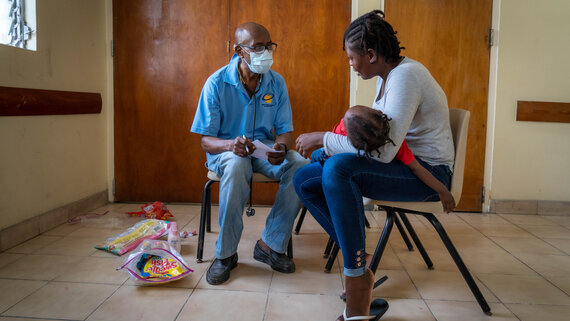
Les Cayes, Haiti
The Gaskov Clergé Foundation provided mobile clinic services at the spontaneous IDP site at the église mormone in Les Cayes. The neighbourhood was badly affected by the August earthquake.
OCHA/Matteo MinasiInsecurity and violence are likely to persist in 2022, with potential consequences in terms of protection (including GBV), displacement, food insecurity, malnutrition and access to basic services. In addition, there are the climatic hazards and risks related to the natural threats that impact Haiti, as well as a projected 2022 active hurricane season, in conjunction with a stronger La Niña between July and October 2022.
While the entire country is exposed to multiple vulnerabilities, these will intensify in areas where there are overlapping crisis factors, such as in the South, Nippes and Grand'Anse departments affected by the earthquake, as well as the Port-au-Prince metropolitan area and regions with a high level of food insecurity.
Response priorities in 2022
In 2022, humanitarian partners will aim to target 2.5 million of the 4.9 million people in need of humanitarian assistance. The response will focus on three priority areas of intervention: (i) acute food insecurity, (ii) needs generated by insecurity and violence and (iii) residual needs following the earthquake. The latter focuses on the return to school, the provision of shelter for the most vulnerable people, the strengthening of health services and the restoration of livelihoods, while ensuring coordination with reconstruction activities and guaranteeing a transversal protection for affected people.
Haiti HRP
Humanitarian partners will strive to achieve the four strategic objectives that the Humanitarian Country Team has identified for the response over the period 2021-2022:
-
Reduce acute vulnerabilities and strengthen resilience through joint efforts of humanitarian and development actors, considering the structural nature of humanitarian needs in Haiti.
-
Increase people’s capacity to meet their basic needs through strengthening access to basic services, improving food security, and decreasing mortality and morbidity due to preventable diseases.
-
Enhance accountability to affected people, particularly to the most vulnerable groups, by strengthening their access to protection services, engaging them in all phases of the response and increasing their self-reliance.
-
Strengthen emergency preparedness and response to restore access to services and autonomy following a disaster, and to contribute to the empowerment of institutions and civil society.
Throughout the response, humanitarian actors will strive to integrate key cross-cutting approaches through dedicated cross-cutting groups (cash, accountability to affected people, access, prevention of sexual exploitation and abuse, and inclusion of persons with disabilities), which will play a leading role in the implementation of these strategic objectives. They will also commit to support the operationalization of the nexus in Haiti by coordinating their actions with development actors to operationalize public policies in relation to social protection, food security and food sovereignty, as well as in the framework of risk reduction linked to natural threats. Finally, partners will engage with national and departmental actors in preparedness and contingency for natural hazards and other scenarios related to the deteriorating situation in the country.
Further reading
Source: Humantiarian Insight
Source: Financial Tracking Service
Source: Office for the Coordination of Humanitarian Affairs
Honduras
Analysis of the context, crisis and needs
The COVID-19 pandemic and Hurricanes Eta and Iota worsened long-standing multidimensional humanitarian conditions in Honduras and significantly weakened the State’s and communities’ coping capacity. The combined effects of a pandemic that caused more than 37,000 COVID-19 cases per every 100,000 inhabitants (the third highest rate in Central America and Mexico), and the back-to-back impacts of two major hurricanes that left 2.8 million people with urgent needs created a dire situation in an already complex humanitarian landscape.
Poverty and violence are rising, while access to basic services is shrinking. The hurricanes damaged or destroyed 10 hospitals and 404 primary health-care facilities, which, added to the partial or temporary closure of health centres during the COVID-19 pandemic, is creating a health coverage deficit. Increasing trends towards protracted droughts linked to El Niño, as well as increasingly heavy rains from tropical storm activity, have had devastating effects on health, food security and livelihoods.
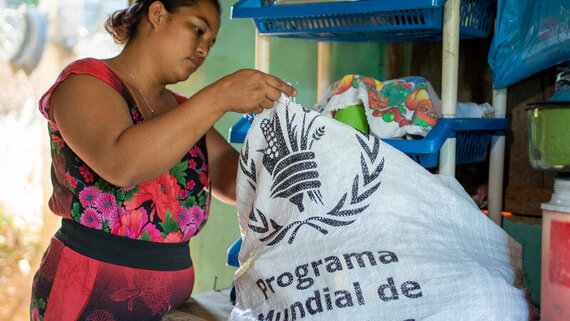
Quimistán, Honduras
This mother of four inspects a bag of scrap metal that she picked up nearby to sell.
WFP/Gerardo AguilarAn estimated 70 per cent of the population, or some 6.6 million people, were living in poverty at the end of 2020, an 11 per cent increase from the 59.3 per cent reported in 2019. With the COVID-19 crisis wiping out more than 500,000 jobs and causing the economy to contract by 6.3 per cent at the end of 2020, livelihoods and economic resilience are likely to continue deteriorating. Some 2.8 million people were suffering crisis levels of food insecurity or worse in February 2021, a number that could grow to 3.2 million at the end of 2021. Extended school closures are affecting more than half a million children, many of whom benefited from school feeding and social protection programmes, which assisted around 1.4 million students before COVID-19. Honduras’s 37.6 homicides per 100,000 inhabitants ranked third among Latin American and Caribbean countries in 2020. That rate includes the highest femicide rate in the region, at 6.2 deaths per every 100,000 women.
More than 937,000 people were internally displaced due to disasters in 2020, the highest number of new displacements in Latin America and the Caribbean. Moreover, Honduras is increasingly becoming a country of transit and destination for people on the move on the region, a situation that could escalate due to deteriorating conditions in Nicaragua. With Honduras set for general elections in November 2021, its socio-political landscape may see renewed turmoil similar to the months-long violence that followed controversial elections in 2017.
Projected situation in 2022 and beyond
Currently, 2.8 million people need humanitarian assistance, more than double the 1.3 million people in need estimated for the Humanitarian Needs Overview issued in early 2020, prior to the COVID-19 pandemic and the impacts of Eta and Iota. Should these needs remain unmet, especially in rural and remote communities, conditions are sure to deteriorate and have a multiplying effect in 2022 and beyond. Vulnerable populations such as women, children, informal workers, indigenous and Afro-descendant people, as well as people living with disabilities, are historically among the people most disproportionately affected by humanitarian situations and will thus require targeted and differentiated response in 2022.
More broadly, structural poverty and weakened resilience capacities will continue to have adverse effects on livelihoods and food security, which will further exacerbate inequality and drive migration within and across borders. The Famine Early Warning Systems Network expects Dry Corridor communities in Honduras to remain in crisis levels of food insecurity at least through January 2022.
Protection is likely to remain a pressing concern. More than 942,000 people require some form of protection due to rampant violence, including gender-based violence and forced displacement. The number of people fleeing the country in search of protection or better conditions has already risen past pre-pandemic levels, as shown by the nearly 320,000 Hondurans detained at the Mexico-United States border between October 2020 and September 2021, surpassing the combined totals of 2019 and 2020 by 19 per cent. Tens of thousands of returnees face protection and basic needs, while burdening already weakened local communities.
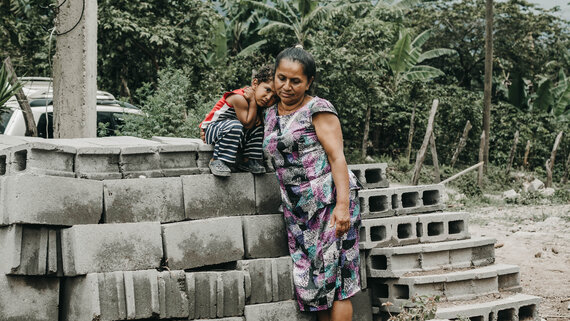
Jesús de Otoro, Honduras
This woman is a community leader in El Aguacate, part of the Jesús de Otoro municipality of Intibucá Department. Humanitarian partners in the region are active in protection, especially with female and GBV-prevention activities, and training local NGOs in women’s rights.
Organización Intibucana de Mujeres Las HormigasThe COVID-19 pandemic is showing a general decline in cases and deaths, but a comparatively late start to vaccination rollouts has led to Honduras reaching only 39 per cent of its population with the complete vaccine scheme, the third lowest coverage in Latin America as of October. In addition to delaying economic recovery, this could continue to draw valuable health response resources and limit response capacities and access to health care, which may exacerbate the spread of other diseases such as dengue, which caused a significant outbreak prior to COVID-19.
Response priorities in 2022
The Humanitarian Country Team will seek to respond to the needs of 1.8 million people, including 612,000 women and 828,000 children across Honduras through the 2021-2022 Humanitarian Response Plan (HRP), requiring US$222 million. The HRP also seeks to strengthen the resilience of social services, communities and affected people, while also prioritizing close coordination with the UN-supported Sustainable Development Reconstruction Plan. The multisectoral response under this plan is targeting those with the most severe needs in 127 priority municipalities, selected out of Honduras’s 298 municipalities following thorough analyses of areas most affected by COVID-19, violence and natural disasters.
Honduras HRP
The HRP is placing a special emphasis on the most affected people, especially those in rural, remote and hard-to-reach communities. Vulnerable groups will be prioritized, such as women, children, displaced people, people living with disabilities, and indigenous and Afro-descendant populations. Food security, WASH, protection and health are the key areas of activity.
Given the current severity and scope of the needs across Honduras, the HRP requirements exceed the combined requirements of Honduras’s last two appeals to respond to Eta and Iota ($90.1 million with $71.5 million funding for 79.3 per cent coverage) and the COVID-19 pandemic ($98 million with $24.5 million funding for 25 per cent coverage). Some initial funding was received in 2021 to kick-start the 18-month plan, but more is needed to ensure a comprehensive response that keeps pace with the growing needs.
Further reading
Source: Humanitarian Insight
Source: Financial Tracking Service
Source: Office for the Coordination of Humanitarian Affairs
Venezuela
Analysis of the context, crisis and needs
Prolonged and significant economic contraction, chronic inflation with episodes of hyperinflation, political polarization and localized violence remain key drivers of humanitarian needs in Venezuela. In 2021, a modest recovery in oil production and a series of liberalizing economic measures have slightly improved economic performance and helped curb inflation. The GDP contraction in 2021 is estimated at 4 per cent, up from -30 per cent in 2020, with the economy expected to grow in 2022. However, the continued economic contraction and the impact of broad sectoral sanctions continue to impact the provision of essential services such as health care, water and sanitation, education and domestic gas, fuel and electricity supply. The deterioration of public service delivery has negatively impacted the lives and livelihoods of vulnerable families. Protection-related services to address violence, abuse, neglect and exploitation, including mental health and gender-based violence (GBV) have also been affected.
COVID-19 has also aggravated the humanitarian situation, with quarantine measures leading to reduced economic activities, including formal employment opportunities, impacting production and trade and increasing domestic violence. People’s incomes, savings and purchasing power have been affected. While food and non-food items are available, vulnerable families face difficulties accessing these due to decreased purchasing power. The informal dollarization of the economy has also led to increased prices, and while there have been regular adjustments to the minimum wage, accompanied by social cash transfers, these are not sufficient for vulnerable families to cover their basic needs, especially for those without access to foreign currency.
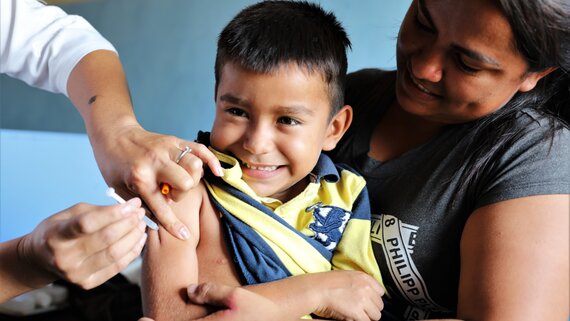
San Joaquin de Navay, Venezuela
A mother holds her smiling son while he receives a measles vaccination at a health clinic in southern Venezuela. She said: "I brought my son for immunization because I don’t want him to fall sick. I know that immunization will strengthen his immune system, which will help him fight other diseases."
OCHA/Gema CortésFood security and nutrition remain a key concern, since the rate of undernourishment has increased from 2.5 per cent in 2010-2012 to 27.4 per cent in 2018-2020.
During 2021, the COVID-19 pandemic heavily strained the health-care system. As of 15 November 2021, 419,745 cases had been confirmed and 5,026 people had died. New variants of the virus have generated new waves of the pandemic. In October, the country reported the highest weekly increase in new cases since the pandemic began, putting pressure on ICU capacity. Limited early access to vaccines constrained the country's initial response. However, as of 12 November, the vaccination rate has increased, with 32.3 per cent of the population fully vaccinated. Key challenges in the COVID-19 response include limitations in regular access to energy, safe water and safe waste-disposal services in health facilities, limited diagnostic capacity and personal protective equipment, and the departure of qualified health personnel.
The focus on COVID-19 curtailed the provision of other essential health services, particularly in the case of chronic diseases and access to sexual and reproductive health, and the implementation of the regular vaccination programme, impacting recent gains in the control of vectorborne diseases.
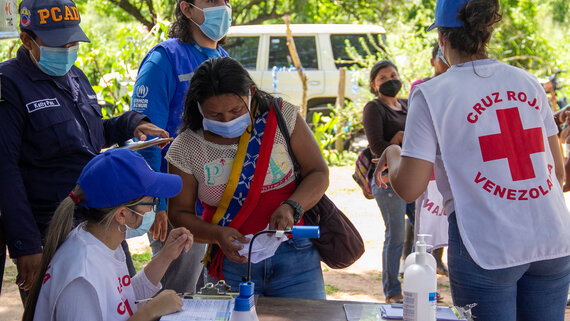
Machiques, Venezuela
In May 2021, dozens of families of the Yukpa ethnic group living in the Apon Basin had to leave their homes due to flooding. By November 2021, UNHCR had delivered more than 800 kits of NFIs to cover basic needs in coordination with the Red Cross, Civil Protection and OCHA.
OCHA/Wildi RiveroThe pandemic also affected people’s well-being, with an increase in mental health and psychosocial support consultations for children, adolescents and caregivers. School closures to mitigate the spread of COVID-19 affected 6.8 million students in the country. Estimates indicate that at least 20 per cent of students had difficulty completing the school year through remote modalities, with children in remote areas, with disabilities and from indigenous communities being the most affected. The return to in-person classes started on 25 October 2021. Ensuring safe conditions in educational facilities and supporting teachers, and vulnerable children and adolescents are critical elements for attendance and retention in the school system.
Mixed migration flows continue, including people intending to leave, returnees and/or people engaged in cross-border pendular movements. The closure of the borders with neighbouring countries throughout most of 2021 forced people to use irregular routes and crossings, which increases protection risks, including human trafficking and gender-based violence.
In 2021, the rainy season affected thousands of people due to overflowing rivers, landslides and floods in several areas of the country, including Apure, Bolivar, Cojedes, Merida, Yaracuy and Zulia states among others.
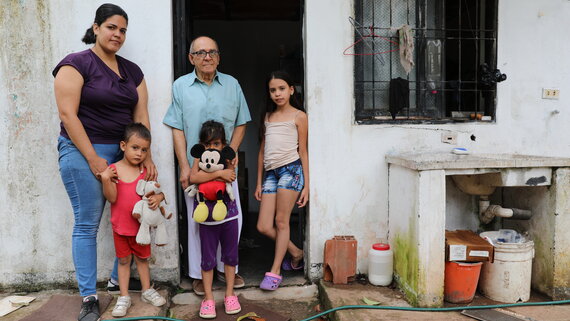
Cardenas, Venezuela
A vulnerable family in front of their house in Cardenas, where living conditions are precarious. While the economic contraction has affected people’s capacity to access food, COVID-19 has turned thousands of lives upside down. The pandemic has hampered the capacity of this mother of three to put food on the table, every morning she worries about how to feed her family.
OCHA/Gema CortésProjected situation in 2022 and beyond
Humanitarian needs are likely to continue due to the prolonged economic and sociopolitical situation and the impact of COVID-19. Critical issues include the delivery of basic services, food insecurity and malnutrition, human mobility and protection needs.
The country’s GDP is expected to grow 1 per cent in 2022 after eight consecutive years of contraction, which could help stabilize the humanitarian situation in 2022. However, sustainable improvements in the economy will depend on lasting progress in the political dialogue and the evolution of international sanctions. Factors such as the extent of economic reform measures, inflation trends, fuel and electricity supply and the ability to rekindle oil production are key for sustained economic changes.
Response priorities in 2022-2023
In 2022, the humanitarian community in Venezuela will focus on:
- Providing life-saving assistance with critical health, including sexual and reproductive health, nutrition, food security, protection and WASH interventions.
- Improving living standards by strengthening livelihoods, maintaining safe and effective access to essential goods and services, and ensuring safe and dignified shelters for people on the move.
- Prevention, mitigation and protection, including those related to GBV and violence, abuse, exploitation and neglect of children and adolescents. Differentiated needs by age, gender and diversity will be considered.
The Humanitarian Response Plan (HRP) will be multi-annual (2022-23), with the aim of promoting better coordination between humanitarian and development interventions, including an increased focus on the delivery of basic services and institutional capacity-building in essential service areas, including protection services.
Venezuela HRP
Strengthening humanitarian access, especially for NGO partners, will continue to be a priority. The main humanitarian challenges include attempts to politicize humanitarian aid, administrative and bureaucratic impediments, fuel shortages, the temporary suspension of cash-based interventions, the lack of access to official data on needs and the slow implementation of the resolution enabling international NGOs to register in the country.
Humanitarian funding also remains a challenge to scaling up the humanitarian response. The HRP funding gap is currently 63 per cent, with total funding against HRP requirements $260 million, and an additional $119 million going to other humanitarian partners (as of 26 November). The establishment of the Venezuela Humanitarian Fund in 2020 mobilized $14 million and facilitated funding opportunities for local partners.
Further reading
Source: OCHA
Source: Humanitarian Insight
Source: Financial Tracking Service
References
- As of October 2021
- World declines of 6.8 per cent GDP and 9.0 per cent employment in 2020.
- UNMAS, Boletín Mensual Colombia August 2021
- OCHA data collected through humanitarian partners and clusters.
- OCHA data collected through humanitarian partners and reviewed by Triangulation Table Information cut-off September 2021.
- COVID-19 generated a decline of nearly a decade in the incidence of moderate and extreme poverty. The incidence of moderate poverty at the national level reached 42.5% of the population, and extreme poverty rose to 15.1%, totalling an increase of 3.6 million people living in moderate poverty and 2.8 million in extreme poverty (Source: DANE 2021).
- According to WFP, first results of COVID-19’s impact on food security and nutrition evaluations (WFP, February 2021), 1.6 million Colombians were in a situation of severe food insecurity, and 22 million in moderate food insecurity. The situation for the Venezuelan population in Colombia is equally worrying: almost 340,000 people are in severe food insecurity and around 850,000 people in a situation of moderate food insecurity.
- The number of People in Need is an estimate from 2019. An updated analysis is ongoing to reflect the most recent humanitarian situation; total population figures are from ECLAC's Statistical Yearbook
- Economic Commission for Latin America and the Caribbean (ECLAC), Economic Survey of Latin America and the Caribbean 2020: Labour dynamics and employment policies for sustainable and inclusive recovery beyond the COVID-19 crisis, p. 101.
- FAO, State of Food Security and Nutrition in the World (SOFI) Report 2021. The Government does not agree with these findings.
- ECLAC-PAHO, COVID-19 Report: The prolongation of the health crisis and its impact on health, the economy and social development, October 2021.
- ECLAC-PAHO, COVID-19 Report: The prolongation of the health crisis and its impact on health, the economy and social development, October 2021.
- PAHO, COVID-19 Vaccination in the Americas, as of 29 October 2021.
- UNESCO, Global monitoring of school closures caused by COVID-19.
- ECLAC, Economic Survey of Latin America and the Caribbean, 2021 (LC/PUB.2021/10-P/Rev.1), Santiago, 2021, p. 103.
- The 2022 figures are estimates and will be updated pending the launch of the HRP 2022-2023

